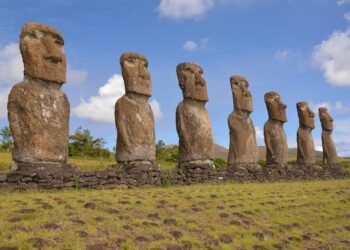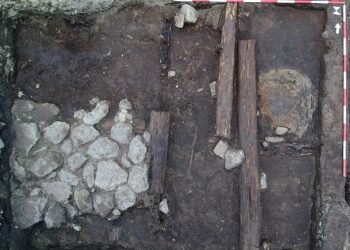Archaeologists from the “Uncovering Roman Carlisle” project have unearthed a delicately carved Roman stone head at the Carlisle Cricket Club in northern England.

This significant find is the third monumental Roman head uncovered at the site, following two similar discoveries in 2023. The stone head, believed to represent a woman, measures approximately 18 cm by 13 cm and features a hairstyle reminiscent of Empress Julia Domna, suggesting it dates back to around CE 193 to 211.
The stone head was found in the southern part of a monumental Roman building, close to where archaeologists previously uncovered the cremated remains of a young woman. The ongoing excavations, which began in 2021, have yielded over 4,000 artifacts, including Roman coins, military relics, painted wall plaster, and even a rare Roman doll’s foot. Lead archaeologist Frank Giecco, Technical Director at Wardell Armstrong, expressed his amazement at the volume and quality of discoveries from the site, calling it “one of the most significant sites on the Roman frontier.”
The excavation site is located near the Roman fort of Uxelodunum, also known as Petriana, which once housed the elite 1,000-strong cavalry unit, the Ala Petriana. This fort was strategically important, controlling the territories west of Carlisle and overseeing a key crossing of the River Eden. The fort’s proximity to the monumental bathhouse suggests that this area served not only as a leisure center but also as a headquarters, or even a Thermae—a Roman complex combining social, religious, and administrative functions.
The “Uncovering Roman Carlisle” project is a community-led initiative aimed at exploring the vast remains of the Roman bathhouse and surrounding structures. It has drawn hundreds of volunteers and visitors, including school groups, to the site, offering an opportunity to engage with live archaeological work. Tours of the excavation are available daily, allowing the public to witness firsthand the unearthing of Carlisle’s Roman past.
Mr. Giecco said, “The discoveries we’ve made here are unique, both in quantity and quality. The stone head, in particular, stands out for its fine craftsmanship, which contrasts with the larger, more monumental heads found last year.” These larger heads, uncovered in May 2023, are believed to represent Roman gods and are thought to have once been part of full-figure sculptures standing up to 15 feet high.
This autumn’s excavation, running from September 21 to October 20, aims to expand the investigation of the monumental structure to the south of the site. In addition to the cremation urn and stone head, archaeologists have uncovered a large building with military artifacts, animal bones, and two intact Roman beakers, likely funeral offerings. The building is now estimated to measure 50 meters by 60 meters.























